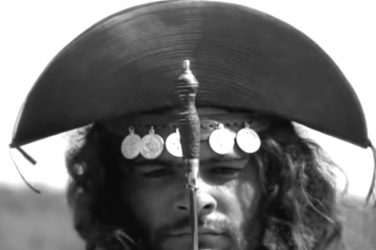Saramago’s style is a cross between the late Thomas Bernhard
and Gabriel Garcia Marquez. He is the live proof that magic realism doesn’t
begin and end with One Hundred Years of Solitude.
Bondo Wyszpolski
Saramago’s style is a cross between the late Thomas Bernhard
and Gabriel Garcia Marquez. He is the live proof that magic realism doesn’t
begin and end with One Hundred Years of Solitude.
Bondo Wyszpolski
The Iberian peninsula (Spain and Portugal) is about to drift away from
the rest of Europe. “Those who are curious, not to say skeptical,
will want to know what is causing all these serious developments, as if
the simple breaking up of the Pyrenees were not enough for them, with rivers
turning into waterfalls and tides advancing several kilometers inland,
after a recession that has lasted millions of years. At this point the
hand falters, how can it plausibly write the words that are about to follow,
words that will inevitably throw everything into jeopardy, all the more
so since it is becoming extremely difficult, should such a thing ever be
possible in life, to separate truth from fantasy.”
All of José Saramago’s novels are fables, if not always by virtue
of the subject matter than by virtue of the rhythm and cadence of his prose.
When we hold one of them open and begin reading — whether it’s The
Stone Raft or its predecessors, Baltasar and Blimunda, The
Year of the Death of Ricardo Reis, The Gospel According to Jesus
Christ — it’s like having a musical score in front of our eyes and
the sudden gift of being able to imagine the sound of the notes, the chords,
the instruments.
As for the style of Saramago’s prose, it’s a cross between the late
Thomas Bernhard and Gabriel Garcia Marquez. Maybe you haven’t read Bernhard?
Then imagine an Austrian intellectual writing The Autumn of the Patriarch.
There’s a cascade of literary rhythm and the drumbeats to move it along,
and the realization that magic realism doesn’t begin and end with One
Hundred Years of Solitude.
Just before the first cracks appear in the Pyrenees separating France
and Spain, Joana Carda scratches the earth of Carbiere and all the mute
dogs set to howling; Joaquim Sassa picks up a heavy stone — and hurls
it far into the Atlantic; Pedro Orce stands up and he’ll forever feel the
ground trembling; José Anaico goes for a walk and a flock of starlings
begins to follow him; and Maria Guavaira begins to unravel a sock only
to find that there’s no end to the thread.
These characters will seek out and encounter one another as the erstwhile
peninsula unmoors and begins sailing west at about 18 kilometers a day.
That’s not all that fast, but soon enough there’s a mass exodus from Lisbon,
Oporto, Coimbra and other coastal cities since nobody wants to be in the
front row when Portugal plows into the Azores. Before that crisis intensifies,
however, Joaquim Sassa has heard about and found José Anaico, the
two of them travel from Portugal to Spain to find old Pedro Orce, these
three then return to Portugal where they meet Joana Carda in Lisbon, and
now this unlikely quartet is driving north, to the site where Joana Carda
had drawn the line in the soil with an elm branch.
They find the spot, they investigate it, if standing around being mystified
can be called investigation, and as they leave they encounter a dog with
a blue thread hanging from its mouth. Somehow, the dog convinces them to
follow him in their jalopy. There’s a great deal of subtle, wry, or understated
humor as the pilgrimage once more gets underway.
“For the second time, Joaquim Sassa said that this was utter madness,
trailing after a stupid dog to the ends of the earth without knowing why
or for what purpose, to which Pedro Orce replied abruptly, betraying his
annoyance, Scarcely to the ends of the earth, we’ll reach the sea before
then.. And in this fashion they arrive in Galicia, northeast of Santiago
de Compostela, stopping only when they approach the doorstep of Maria Guavaira,
the woman who’d begun to unravel a sock to no avail.
This review, long enough already, would be twice as long if I explained
the personal relationships that develop as the characters come to know
one another. Even the dog, tentatively called Pilot and Faithful for a
few pages, is permanently named Constant (but — mistakenly? — called
Ardent in the closing paragraph). Soon enough there are even a couple of
horses, Grizzly and Chess.
What is the book about? Uprootedness and displacement, obviously; everything’s
on the move in this book, and there appears to be a certain amount of political
allegory as well. One senses that continental Europe is secretly pleased
to see its southern neighbors floating off into the sunset; likewise, the
United States is magnanimous when it seems that the island will rip itself
up when it strikes the Azores. Later on, however, the US and Canada demur
at the prospect of a new neighbor settling down in territorial waters.
There are some interesting and surprising twists and turns as The
Stone Raft comes to an end, not the least being that most of the women
on the island are pregnant. One will ask, What does this imminent mass
birth signify? It’s just one more puzzle for the reader who wants to delve
deeper into this often very delightful book, a book in which “the
journey continues.”
Portugal’s José Saramago is a worldclass writer — I’m always
telling people I meet that he deserves the Nobel Prize — but I’d give
his three other books in English a slightly higher recommendation. Deceiving
words, to some extent, because The Stone Raft is full of wonderful
lines and wonderful moments that we simply won’t find anywhere else.
Excerpt:
Overcome evil with good, the ancients used to say, and with good reason,
at least they put their time to good use by judging facts that were then
new in the light of facts that were already old. Nowadays we make the mistake
of adopting a skeptical attitude toward the lessons of antiquity. The President
of the United States of America promised that the peninsula would be welcome,
and Canada, as we will see, was not pleased. As the Canadians point out,
Unless the peninsula changes course, it we who will be playing host and
then we’ll have two Newfounlands here instead of one, little do the people
on the peninsula know, poor devils, what awaits them, biting cold, frost,
the only advantage for the Portuguese is that they will be close to supplies
of that cod they’re so fond of. They will lose their summers but have more
to eat.
The spokesman at the White House hastened to explain that the President’s
speech had been prompted fundamentally by humanitarian considerations without
aspiring to political supremacy, especially since the countries of the
peninsula had not ceased to be sovereign and independent just because they
had gone floating off over the waters, they will have to come a halt one
day, and be like every other country, and then added, For our part, we
solemnly guarantee that the traditional good-neighbor policy between the
United States and Canada will not be affected by any eventuality, and as
proof of America’s desire to maintain friendly relations with the great
Canadian nation, we propose setting up a bilateral committee to examine
the various problems arising in the context of this dramatic transformation
of the world’s political and strategic physiognomy, which certainly constitutes
a first step toward the birth of a new international community comprising
the United States, Canada, and now the Iberian countries, who will be invited
to participate as observers at this meeting since they are still not physically
close enough for there to be any immediate prospect of specifying the eventual
form of this integration.
The Stone Raft, by José Saramago, translation
by Giovanni Pontiero (Harvest Books, 304 pp., $13 paper)








